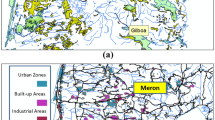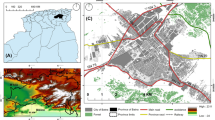Abstract
This paper presents a conceptual framework for geosimulation of the New-build gentrification process in an integrated approach. The combination of Multi-Criteria Evaluation (MCE) and Geographic Automata Systems (GAS) facilitates to translate the expert Knowledge into model rules. Analytic Network Process (ANP) is considered as MCE that addresses the relative importance of criteria for New-build gentrification as a complex urban phenomenon. It will be used to determine the different weights of each parameter in every time elapse. GAS which unites Cellular Automata (CA) and Multi-agent Systems (MAS) provides an excellent tool for modeling New-build gentrification. The transition rules are proposed as a combination of land use transformation and residential decision for housing area. The land use change is based on human-agent effects (local authority, neighborhood’s property value and developer) and residential decision is the adaptation of a stress-resistance hypothesis defined by Benenson (2004). The integrated approach is believed to provide a more accurate real-world urban modeling and simulation that can highlight the systematic inequalities of urban context based on the theory of New-build gentrification.


Similar content being viewed by others
References
Alonso, W. (1964). Location and land use: Toward a general theory of land rent. Cambridge: Harvard University Press.
Batty, M. (2005). Cities and complexity understanding cities with cellular automata, agent-based models, and fractals. Massachusetts: The MIT.
Batty, M., & Longely, P. (1994). Fractal cities: A geometry of form and function. San Diego: Academic.
Benenson, I. (1998). Multi-agent simulations of residential dynamics in the city. Computers, Environment and Urban Systems, 22(1), 25–42.
Benenson, I. (2004). Agent-based modeling: From individual residential choice to urban residential dynamics. In M. F. Goodchild, & D. G. Janelle. Spatially integrated social science: Examples in best practice (pp. 67–95). Oxford University Press
Benenson, I., & Torrens, P. M. (2004). Geosimulation automata-based modeling of urban phenomena. Wiley
Benenson, I., Martens, K., & Birfir, S. (2008). PARKAGENT: An agent-based model of parking in the city. Computers, Environment and Urban Systems, 32, 431–439.
Bertalanffy, L. V. (1972). General system theory. Harmondsworth, Middlesex: Penguin Books.
Bounds, M., & Morris, A. (2006). Second wave gentrification in inner-city Sydney. Cities, 23, 99–108.
Briassoulis, H. (2008). Land-use policy and planning, theorizing, and modeling: Lost in translation, found in complexity. Environment and Planning B: Planning and Design, 35, 16–33.
Carsjens, G. J., & Ligtenberg, A. (2007). A GIS-based support tool for sustainable spatial planning in metropolitan areas. Landscape and Urban Planning, 80, 72–83.
Chakhar, S., & Lamsade, V. M. (2008). Multicriteria decision making, spatial. In S. Shekhar & H. Xiong (Eds.), Encyclopedia of GIS (pp. 776–782). New York: SpringerScience + Business Media, LLC.
Chen, Y., Wong, S., Su, H. (2007). Revisit the threshold effect of neighborhood change using multi-agent simulation: A case of Philadelphia. Computers in Urban Planning and Urban Management. Iguassu Falls, Brazil
Crooks, A. T. (2008). Constructing and implementing an agent-based model of residential segregation through vector GIS. London: Centre for Advanced Spatial Analysis, University College London.
Crooks, A., Castle, C., & Batty, M. (2008). Key challenges in agent-based modelling for geo-spatial simulation. Computers, Environment and Urban Systems, 32, 417–430.
Daffertshoffer, A., Haken, H., & Portugali, J. (2001). Self-organized settlements. Environment and Planning B: Planning and Design, 28, 89–102.
Davidson, M. (2006). New build gentrification: London’s riverside renaissance. London: London, King’s College.
Davidson, M., & Lees, L. (2005). New-build “gentrification” and London’s riverside renaissance. Environment and Planning A, 37(7), 1165–1190.
Diappi, L., & Bolchi, P. (2007). Smith’s rent gap theory and real estate dynamics: A multi-agent model. Computers, Environmnet and Urban Systems
Dietzel, C., & Clarke, K. (2006). The effect of disaggregating land use categories in cellular automata during model calibration and forecasting. Computers, Environment and Urban Systems, 30, 78–101.
Durrett, R., & Levin, S. A. (1994). Stochastic spatial models: A user’s guide to ecological applications. Philosophical Transactions: Biological Science, 343, 329–350.
Guzey, O. (2006). Understanding the logic of gentrification in different geographies: A comparison of five regeneration projects in Ankara Turkey. 42nd ISoCarp (pp. 1–13). Ankara: Turkey
Guzey, O. (2009). Urban regeneration and increased competitive power: Ankara in an era of globalization. Cities, 26, 27–37.
Ha, S.-K. (2004). Housing renewal and neighborhood changes as a gentrification process in Seoul. Cities, 21(5), 381–389.
Hammam, Y. (2008). Geographical vector agents. Department of informatic science. Dunedin: The University of Otago.
Hamnett, C. (1991). The blind men and the elephant: The explanation of gentrification. Transactions of the Institutes of British Geographers, 16, 173–189.
Hamnett, C., & Whitelegg, D. (2007). Loft conversion and gentrification in London: From industrial to postindustrial land use. Environment and Planning A, 39, 106–124.
Hatami Nejad, H., Sabri, S., & Sabri, S. (2008). The essence of a public-private partnership in Redevelopment of Abkooh neighborhood of Mashhad–Iran through a sustainable development. International conference on Social Science and Humanities. Penang: University Sains Malaysia.
Howley, P., Scott, M., & Redmond, D. (2009). An examination of residential preferences for less sustainable housing: Exploring future mobility among Dublin central city residents. Cities, 26, 1–8.
Jackson, J., Forest, B., & Sengupta, R. (2008). Agent-based simulation of urban residential dynamics and land rent changing in a gentrifying area of Boston. Transactions in GIS, 12(4), 475–491.
Keskin, B. (2008). Hedonic analysis of price in the Istanbul housing market. International Journal of Strategic Property Management, 12, 125–138.
Khalesian, M., Pahlavani, P., Delavar, M. R. (2008). GIS-based multi-agent traffic micro simulation for modelling the local air pollution. The International archives of the Photogrametry, Remote Sensing and Spatial Information Sciences
Lees, L., Slater, T., & Wyly, E. (2008). Gentrification. New York: Routledge.
Levy, J. K. (2005). Multiple criteria decision making and decision support systems for flood risk management. Stochastic Environmental Research and Risk Assessment, 19, 438–447.
Li, X., & Yeh, A. G.-O. (2001). Calibration of cellular automata by using neural networks for the simulation of complex urban systems. Environment and Planning A, 33, 1445–1462.
Ligtenberg, A., Bregt, A. K., & Van Lammeren, R. (2001). Multi-actor-based land use modeling: Spatial planning using agent. Landscape and Urban Planning, 56, 21–33.
Ligtenberg, A., Wachowicz, M., Bregt, A. K., Beulens, A., & Ketten, D. L. (2004). A design and application of a multi-agent system for simulation of multi-actor spatial planning. Journal of Environmental Management, 72, 43–55.
Liu, Y. (2009). Modelling urban development with geographical information systems and cellular automata. Boca Raton: CRC.
Macal, C. M., & North, M. J. (2005). Tutorial on agent-based modeling and simulation. Proceedings of 2005 Winter Simulation Conference
Makse, H. A., Halvin, S., & Stanley, H. E. (1995). Modelling urban growth patterns. Nature, 377, 608–612.
Makse, H. A., Andrade, J. S., Batty, M., & Halvin, S. (1998). Modeling urban growth patterns with correlated percolation. Physical Review E, 58, 7054–7062.
Malczewski, J. (1999). GIS and multicriteria decision analysis. New York: John Wily & Sons.
Nyerges, T. L., & Jankowski, P. (2010). Regional and urban GIS a decision support approach. New York: The Guilford.
O’Sullivan, D. (2001). Graph cellular automat: A generalised discrete urban and regional model. Environment and Planning B: Planning & Design, 28, 667–684.
O’Sullivan, D. (2002). Toward micro-scale spatial modeling of gentrification. Geographical Systems, 4, 251–274.
O’Sullivan, D. (2009). Changing neighborhoods-neighborhoods changing, a framework for spatially explicit agent-based models of social systems. Sociological Methods & Research, 37(4), 498–530.
Parker, D. C., & Filatova, T. (2008). A conceptual design for a bilateral agent-based land market with heterogeneous economic agents. Computers, Environment and Urban Systems, 32, 454–463.
Portugali, J., Benenson, I., & Omer, I. (1997). Spatial cognitive dissonance and sociospatial emergence in a self-organizing city. Environment and Planning B: Planning and Design, 24, 263–285.
Pourebrahim Abadi, S. (2008, December). Integrated coastal land use development; using Analytic Network Process and GIS: Case of Kuala Langat District, Malaysia. PhD Thesis. University Putra Malaysia, Selangore, Malaysia: Unpublished
Saaty, T. L. (2007). Time dependent decision-making; dynamic priorities in the AHP/ANP: Generalizing from points to functions and from real to complex variables. Mathematical and Computer Modelling, 46, 860–891.
Saaty, T. L., & Kearns, K. P. (1985). Analytical planning, the organization of systems. Oxford: Pergamon Press Ltd.
Saaty, T. L., & Takizawa, M. (1986). Dependence and independence: From linear hierarchies to nonlinear networks. European Journal of Operational Research, 26(2), 229–237.
Saaty, T. L., & Vargas, L. G. (2006). Decision making with the analytic network process, economic, political, social and technological applications with benefits, opportunities, costs and risks. Pittsburgh: Springer.
Sabri, S., & Yakuup, A. (2008a). Multi-criteria decision making for urban sprawl, using Analytic Network Process and GIS, Case of Iskandar Malaysia Region. Map Asia 2008. Kuala Lumpur: GIS Development.
Sabri, S., & Yakuup, A. (2008b). Integrating dynamic network process (DNP) analysis and geographical information system (GIS) to introduce the components of urban gentrification in developing countries. Asia GIS 2008. Busan, Korea: Asia GIS 2008
Sabri, S., & Yakuup, A. (2008c). Multi-criteria expert based analysis for ranking the urban gentrification drivers in developing countries. Built Environment in developing countries. Penang: USM
Sabri, S., Mosharzadeh, Z., & Hataminejad, H. (2006). The essence of generation a public-private partnership in empowerment of ABKOOH quarter of Mashad city—a sustainable development approach. In A. Atkinson & M. Graetz (Eds.), Proceedings: International conference and summer school 2006, Berlin University (pp. 224–233). Berlin: ISR Sonderpublikation.
Schelling, T. C. (1971). Dynamic models of segregation. The Journal of Mathematical Sociology, 1(2), 143–186.
Sengupta, R. R., & Bennett, D. A. (2003). Agent-based modelling environment for spatial decision support. International Journal of Geographical Information Science, 17(2), 157–180.
Sengupta, R., Lant, C., Kraft, S., Beaulieu, J., Peterson, W., & Loftus, T. (2005). Modeling enrollment in the Conservation Reserve Program by using agents within spatial decision support systems: An example from southern Illinois. Environment and Planning: Planning and Design, 32, 821–834.
Smith, N. (1996). The new urban frontier: Gentrification and the Revanchist city. London: Routledge.
Speare, A. J., Goldstein, S., & Frey, W. H. (1974). Residential mobility, migration, and metropolitan change. Ballinger: Cambridge, Mass.
Timmermans, H., & Noortwijk, L. V. (1995). Context dependencies in housing choice behavior. Environment and Planning A, 27(2), 181–192.
Torrens, P. M. (2007). A geographical automata model of residential mobility. Environment and Planning B: Planning and Design, 34, 200–222.
Torrens, P., & Nara, A. (2007). Modeling gentrification dynamics: A hybrid approach. Computers, Environment and Urban Systems, 337–361
Trajkovski, G. (2007). An imitation-based approach to modeling homogenous agents societies. Hershey & London: Idea Group Publishing.
Van de Vyvere, Y. (1994). Stated preference decompositional modelling and residential choice. Geoforum, 25(2), 189–202.
Wachowicz, M., Ying, X., Ligtenberg, A. (2001). Land use change explorer: A tool for geographic knowledge discovery. Wageningen University
Ward, D. P., Murray, A., & Phinn, S. (2000). A stocastically constrained cellular model of urban growth. Computers, Environment and Urban Systems, 24, 539–558.
White, R., & Engelen, G. (1997). Cellular automata as the basis of integrated dynamic regional modelling. Environment and Planning B: Planning and Design, 24(2), 235–246.
White, R., Engelen, G., & Uljee, I. (1997). The use of constrained cellular automata for high-resolution modelling of urban land-use dynamics. Environment and Planning B: Planning and Design, 24(3), 323–343.
Wu, F. (1996). A linguistic cellular automata simulation approach for sustainable land development in a fast growing region. Computers, Environment and Urban Systems, 20(6), 367–387.
Wu, F. (1998). SimLand: A prototype to simulate land conversion through the integrated GIS and CA with AHP-derived transition rules. International Journal of Geographical Information Science, 12(1), 63–82.
Wu, F. (2002). Calibration of stochastic cellular automata: The application to rural-urban land conversions. International Journal of Geographical Information Science, 16(8), 795–818.
Wu, B., Birkin, M., & Rees, P. (2008). A spatial microsimulation model with student agents. Computers, Environment and Urban Systems, 32, 440–453.
Yeh, A. G.-O., & Li, X. (2006). Errors and uncertainties in urban cellular automata. Computers, Environment and Urban Systems, 30, 10–28.
Author information
Authors and Affiliations
Corresponding author
Rights and permissions
About this article
Cite this article
Sabri, S., M. Ludin, A.N.M. & Ho, C.S. Conceptual Design for an Integrated Geosimulation and Analytic Network Process (ANP) in Gentrification Appraisal. Appl. Spatial Analysis 5, 253–271 (2012). https://doi.org/10.1007/s12061-011-9069-5
Received:
Accepted:
Published:
Issue Date:
DOI: https://doi.org/10.1007/s12061-011-9069-5




